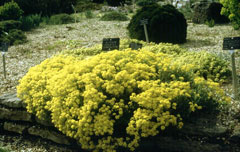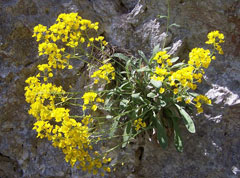 |
|
(c) 2010 Ken Fern & Plants For A Future |
 |
| http://commons.wikimedia.org/wiki/User:Selso |
Translate this page:
Summary
Bloom Color: Yellow.
Main Bloom Time: Early spring, Mid spring. Form: Spreading or horizontal.
Physical Characteristics

 Aurinia saxatilis is an evergreen Perennial growing to 0.3 m (1ft) by 0.3 m (1ft in) at a medium rate.
Aurinia saxatilis is an evergreen Perennial growing to 0.3 m (1ft) by 0.3 m (1ft in) at a medium rate.
See above for USDA hardiness. It is hardy to UK zone 3. It is in leaf all year, in flower from April to June, and the seeds ripen in July. The species is hermaphrodite (has both male and female organs) and is pollinated by Bees, Lepidoptera (Moths & Butterflies). The plant is self-fertile.
It is noted for attracting wildlife.
Suitable for: light (sandy), medium (loamy) and heavy (clay) soils, prefers well-drained soil and can grow in nutritionally poor soil. Suitable pH: mildly acid, neutral and basic (mildly alkaline) soils. It cannot grow in the shade. It prefers dry or moist soil and can tolerate drought.
UK Hardiness Map
US Hardiness Map
Synonyms
Alyssum saxatile. L.
Plant Habitats
Ground Cover; East Wall. In. South Wall. In. West Wall. In.
Edible Uses
References More on Edible Uses
Medicinal Uses
Plants For A Future can not take any responsibility for any adverse effects from the use of plants. Always seek advice from a professional before using a plant medicinally.
None known
References More on Medicinal Uses
The Bookshop: Edible Plant Books
Our Latest books on Perennial Plants For Food Forests and Permaculture Gardens in paperback or digital formats.

Edible Tropical Plants
Food Forest Plants for Hotter Conditions: 250+ Plants For Tropical Food Forests & Permaculture Gardens.
More

Edible Temperate Plants
Plants for Your Food Forest: 500 Plants for Temperate Food Forests & Permaculture Gardens.
More

More Books
PFAF have eight books available in paperback and digital formats. Browse the shop for more information.
Shop Now
Other Uses
A good ground cover plant for a sunny position[188, 197], forming a slowly spreading carpet of growth[208].
Special Uses
Attracts Wildlife Ground cover
References More on Other Uses
Cultivation details
Landscape Uses:Border, Ground cover, Massing, Rock garden, Specimen. Succeeds in most soils[111]. Prefers a sunny position and a well-drained soil[1, 200]. Best when grown in a soil that is not too rich[200]. Drought tolerant once established[190], plants can be grown on dry-stone walls and also old brick walls[208, 219]. A very ornamental plant[1], there are several named varieties[190]. A good bee and butterfly plant[30]. Special Features:
Naturalizing, Attracts butterflies, Fragrant flowers.
References Carbon Farming Information and Carbon Sequestration Information
Temperature Converter
Type a value in the Celsius field to convert the value to Fahrenheit:
Fahrenheit:
The PFAF Bookshop
Plants For A Future have a number of books available in paperback and digital form. Book titles include Edible Plants, Edible Perennials, Edible Trees,Edible Shrubs, Woodland Gardening, and Temperate Food Forest Plants. Our new book is Food Forest Plants For Hotter Conditions (Tropical and Sub-Tropical).
Shop Now
Plant Propagation
Seed - surface sow March in a greenhouse. The seed usually germinates in 1 - 2 weeks at 16c[133]. When they are large enough to handle, prick the seedlings out into individual pots and plant them out in the summer. The seed can also be sown outdoors, either in a seedbed or in situ. Division in March or October[111]. Larger divisions can be planted straight into their permanent positions whilst smaller clumps are best potted up and kept in a cold frame until they are growing away well. Cuttings in early summer[1, 111].
Other Names
If available other names are mentioned here
Native Range
TEMPERATE ASIA: Turkey (west), Georgia EUROPE: Austria, Czech Republic, Germany, Hungary, Poland, Slovakia, Ukraine, Albania, Bulgaria, Greece (incl. Crete), Croatia, Italy (south), Montenegro, Romania, Serbia, Slovenia
Weed Potential
Right plant wrong place. We are currently updating this section.
Please note that a plant may be invasive in one area but may not in your area so it's worth checking.
Conservation Status
IUCN Red List of Threatened Plants Status :

Growth: S = slow M = medium F = fast. Soil: L = light (sandy) M = medium H = heavy (clay). pH: A = acid N = neutral B = basic (alkaline). Shade: F = full shade S = semi-shade N = no shade. Moisture: D = dry M = Moist We = wet Wa = water.
Now available:
Food Forest Plants for Mediterranean Conditions
350+ Perennial Plants For Mediterranean and Drier Food Forests and Permaculture Gardens.
[Paperback and eBook]
This is the third in Plants For A Future's series of plant guides for food forests tailored to
specific climate zones. Following volumes on temperate and tropical ecosystems, this book focuses
on species suited to Mediterranean conditions—regions with hot, dry summers and cool, wet winters,
often facing the added challenge of climate change.
Read More
Expert comment
Author
(L.)Desv.
Botanical References
100200
Links / References
For a list of references used on this page please go here
Readers comment
| Add a comment |
|
If you have important information about this plant that may help other users please add a comment or link below. Only comments or links that are felt to be directly relevant to a plant will be included. If you think a comment/link or information contained on this page is inaccurate or misleading we would welcome your feedback at [email protected]. If you have questions about a plant please use the Forum on this website as we do not have the resources to answer questions ourselves.
* Please note: the comments by website users are not necessarily those held by PFAF and may give misleading or inaccurate information.
To leave a comment please Register or login here All comments need to be approved so will not appear immediately.
|
Subject : Aurinia saxatilis
|
|
|
|